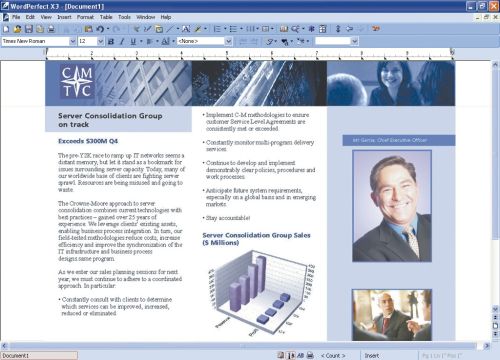Corel gives WordPerfect Office one more round
Ottawa (Canada) - If all the features that a word processor user would ever require have already been invented, as some well-known reviewers have claimed, then apparently the people at Corel didn't get the memo. Over a decade has passed since the WordPerfect brand was tarnished by its former caretakers, who released its first Windows-based edition over a year late, and still somehow not ready for prime time. Now, Corel is hoping the applications market has forgotten all about that debacle, and may be willing to embrace a new edition of WordPerfect that sticks to very conservative functionality principles.
A first look at the screen capture Corel made available in its Reviewers' Guide this morning reveals absolutely nothing spectacular. This may be Corel's intention: The appearance and layout of menus and toolbar gadgets is obviously designed to appeal to users very familiar with Microsoft Word. Here, menu items are in the same location, and toolbar buttons generally have the same arrangement, although the icons are at least slightly different to avoid lawsuits. The "document tab" feature remains along the status bar of the active document, however, as perhaps the last persistently visible remnant of the product's ill-fated makeover by Novell, when it was first paired with the Quattro Pro spreadsheet (then manufactured by Borland, now also part of the Corel WP Office suite).
What continues to distinguish WordPerfect from Microsoft Word, even in this newest X3 release, is how it handles what WordPerfect calls "codes." Since its inception as a DOS-based word processor, WordPerfect has treated every native document as a stream of characters whose formatting is altered inline through the insertion of codes. Back before WordPerfect could preview the appearance of a document graphically before the user printed it, codes such as changing to boldface and back to normal again, showed up as tags that surrounded a passage of text - a kind of markup which was inspired by SGML typesetting code, and which helped spur the notion of HTML itself.
Since Microsoft Word's native documents have never been streams of characters altered inline (at least, not up until it adopts an XML format as standard with its next, Vista-oriented edition), it has never bothered with representing markup codes, or the equivalents thereof, on-screen. But markup code visibility has always been a hallmark feature of WordPerfect, and continues to be with the X3 edition, especially for use by professionals who have to prepare each document to its own exacting standards, rather than only the general principles set forth by a document template.
Another case the X3 edition could possibly make for itself is that it behaves more like Office than Office itself. With Microsoft's next release - which will probably come in tandem with the unveiling of Vista late this year - the look and feel will be noticeably, drastically different. Unless Microsoft changes its mind, menu bars themselves will be replaced with tear-off palettes, whose apportioned functions will be represented by multiple types of on-screen gadgets. If WordPerfect Office keeps its current, conservative look, Corel could be betting there are new customers - especially large ones with training budgets - willing to switch allegiances in order to stay the same.
But Corel's other big play - adherence to standards - could face a tough road ahead. The original WordPerfect document standard has long since fallen into obscurity. Corel is hoping that WordPerfect's capability to import and export Adobe PDF files, as well as Microsoft Word files, will ease customers' transitions, as well as allay their fears about possibly jumping on a bandwagon headed the same direction as the last WPD format. But compatible formats and "open formats" aren't the same; and the objections that some state government offices have recently raised about Microsoft Word not adhering to "open standards" may not exactly be quelled by WordPerfect Office X3.
What could also end up being a deficiency for the new release, in the end, could be its extensibility - or lack thereof. Ever since Novell, in 1994, released a Windows version of WordPerfect that it acknowledged contained a defective macro processor, and declined to provide a fix for it, customer incentive to build and utilize macros for WordPerfect - a cottage industry in the 1980s - dwindled to near-zero. Recently, Corel's latest version of its PerfectScript macro language for WordPerfect has actually been a version of Visual Basic for Applications (VBA) - the same language used in Office XP - licensed from Microsoft.
Get Tom's Hardware's best news and in-depth reviews, straight to your inbox.
But literature released by Corel in conjunction with the X3 release refers to both VBA and a PerfectScript language "developed specifically for WordPerfect Office applications." Even if all Corel did was renovate the underlying PerfectScript type libraries, while keeping the VBA platform, Microsoft Office in the meantime is moving to an entirely new automation platform that will reportedly utilize the customer's choice of languages, though with the .NET Framework as the automation module rather than VBA. So Corel's claim of compatibility may be quickly eroding in the face of platform evolution.
The new, complete Office X3 suite, which features Quattro Pro and a presentations manager - but no database - will retail for a suggested $160 (CAN $200). Though the product is supposedly available immediately, online retailers still showed the previous edition, WordPerfect Office 12, in their catalogs.
